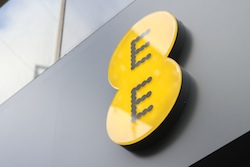EE has announced plans to double the average speed of its 4G LTE network and to achieve one million customers by the end of this year.
The UK operator has also announced that it will be trialling carrier aggregation, a fundamental feature of LTE-Advanced, combining spectrum from different bands in order to further boost performance, speed and capacity.
“We are confident that we will reach 300Mbps throughput on our 1800 MHz spectrum by the end of 2013,” said EE CEO Olaf Swantee at the press conference in London this morning.
The maximum mobile broadband speed currently attainable on EE’s 4G LTE network is 18 Mbps, but EE said it was aiming for an average of 20Mbps this summer.
To achieve the new speed, the operator said it had refarmed an extra 10MHz of spectrum from its legacy 2G networks gained from the Orange T-Mobile merger to its new 4G network. Trials using the additional spectrum in Cardiff have so far seen a top speed of 80Mbps.
EE intends to roll out increased speeds in 10 cities across the UK in parallel with its ongoing 4G LTE network roll-out – last month it revealed that it has covered 50 UK towns and cities, and is also reaching half of the country’s population.
The operator added that it plans to sign up one million 4G customers by the end of this year and cover 98 percent of the UK with 4G LTE services a year later.
“Our engineers tell us that the data traffic on our network will increase seven-fold in the next three years as users have a much greater demand for data,” said Swantee.
“Typically in the US, operators delivering 4G have been able to achieve 10 percent of the market share after 24 months. If we get one million 4G customers by Christmas 2013, we will have achieved eight percent of the market in 14 months.
“We have now secured 36 percent of all the spectrum in the UK. In fact we have so much spectrum now that we could carry every single mobile user in the UK and deliver a solid voice, text, data service to those customers.
“It was technically not possible to do it a few months ago, but we have now secured the spectrum capacity for the long run to sustain differentiation and capability.”
Recent research by Ovum has shown that the 1800 MHz band of spectrum is rapidly becoming the one of the most important bands for 4G LTE, due to the savings enabled by re-farming existing 1800 MHZ spectrum and re-using existing sites and masts.
According to EE’s Director of Network Integration & LTE Mansoor Hanif, there has never been a situation where an operator has more spectrum than the current user demand.
“We knew right from the beginning that as more customers join our network, we would need to provide more bandwidth and capacity. We need to maintain voice quality on the 2G [network] while we shift spectrum over to the 4G, and also provide extra spectrum when we need it,” said Hanif.
“By bringing 2G, 3G and 4G networks together, we have a big block of spectrum with much more capability and we have seen the service quality KPIs improve massively.”
When asked about how much HSPA+ capability EE has and how it would aid their existing data services, Swantee said that it was not enough.
“EE now has 75 percent HSPA+ dual-cell capacity throughout our network and if you are in an area where there is no 4G, you will have a very good 3G service. But let’s be clear – the 3G network was not designed for mobile internet, for accessing Facebook, downloading films, uploading photos, even though HSPA+ does help from a software point of view to strengthen performance.”




